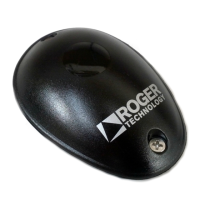8
5.2 Wiring
WARNING: connect wires with the power turned o.
Arrange the cables: you will need 3 wires to connect the TX
and a maximum of 5 wires to connect an RX (the number
depends on how you connect the output of the photocell).
Connect the power supply while ensuring correct polarity.
ATTENTION: even in case of AC power supply, connect all
TX and RX with the same polarity.
Connect all photocells with the synchronizaon wire
(SYNC).
If needed, connect the output terminals OUT.
Figure 8 depicts a typical set-up of 4 photocell pairs: 2 pairs
mounted at dierent heights on the outside of the gate
(PHOTO1 and PHOTO2) and 2 pairs mounted at dierent
heights inside the gate (PHOTO3 and PHOTO4). Input FT1
of the control unit is connected to the outputs of PHOTO1
and PHOTO2 connected in series. Input FT2 of the control
unit is connected to the outputs of PHOTO3 and PHOTO4
connected in series.
Figure 9 depicts a typical set-up of 2 photocell pairs
(PHOTO1 and PHOTO2) a pair on the inside (FOTO1) and
another outside the gate (FOTO2). Input FT1 of the control
unit is connected to the output of PHOTO1. Input FT2 of
the control unit is connected to the output of PHOTO2.
5.3 Conguraon and alignment
Set-up a pair of photocells as MASTER (jumper ID1 and
ID2, see gure 5).
WARNING: there must always be a single MASTER pair.
Congure the other pairs of photocells as SLAVE (jumper
ID1 and ID2, see gure 5), all SLAVE pairs must have a
dierent conguraon.
WARNING: It is essenal to change the posion of the
jumpers when in the absence of voltage, since their
conguraon is only detected upon ignion.
CAUTION: When you set the alignment mode with the
jumper SET (see gure 4) the output OUT becomes
disabled, as its contact is always open. At the end of the
alignment procedure, ensure that the jumper SET is in the
normal operang posion (see gure 3).
The alignment procedure is performed on one pair of
photocells at a me while observing the ashing of LED
L2 (on RX, gure 1), which represents the intensity of
the received signal: the ashing is faster if the signal is
stronger, is slower if it is weaker.
To align the rst pair of photocells (MASTER), proceed as
follows:
• Set to alignment mode (jumper SET see gure 4) on the
pair of MASTER photocells.
• Turn on the power.
• Move the photocell unl you nd the locaon where
the ashing of LED L2 is the fastest.
• Mount the photocell at the locaon where the signal is
best, taking care to maintain that posion.
• Cut the power.
• Move the jumper SET to the normal operaon posion
on the TX and RX (see gure 3).
NOTE: under opmal alignment condions it is possible
that LED L2 remains solidly lit.
If there are no SLAVE photocells, the procedure is over.
If there are SLAVE photocells present, temporarily
congure the pair of MASTER photocells as you would
congure any SLAVE (jumper ID1 and ID2, see gure 5),
it does not maer if there is another SLAVE with the same
conguraon. This is done so as not to interfere with the
next photocells that need alignment.
• Set to alignment mode (jumper SET, see gure 4) on the
rst pair of SLAVE photocells.
• Turn on the power.
• Move the photocell unl you nd the locaon where
the ashing of LED L2 is the fastest.
• Mount the photocell at the locaon where the signal is
best, taking care to maintain that posion.
• Cut the power.
• Move the jumper SET to the normal operaon posion
on the TX and RX (see gure 3).
• Repeat the procedure with all other pairs of SLAVE
photocells.
Once all pairs of photocells are aligned:
• Return the rst pair of photocells that had momentarily
been congured as SLAVE to the MASTER conguraon.
• Make sure the jumper SET of all photocells, TX and RX
are all in the normal posion (see gure 3).
5.4 Container Closure
To close the photocell containers proceed as follows:
R90/F4ES
• Check that the seal (detail A, gure 6) is correctly
inserted in the upper shell.
• Posion the top shell and secure it using the two
supplied screws.
• Insert the two caps to cover the screw holes (detail B,
gure 6).
G90/F4ES
• Place the gasket (O-ring, detail C, gure 7 in the groove
of the upper shell.
• Posion the gasket (detail D, gure 7) and the upper
shell and secure with the two supplied screws.
• Gently press the mask (detail E, gure 7) unl it clicks.
6 Tesng
Tesng allows for the vericaon of the correct operaon
of the photocells and of possible interference caused by

